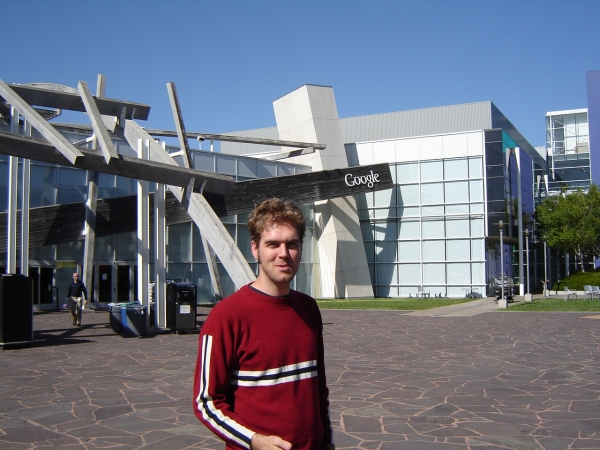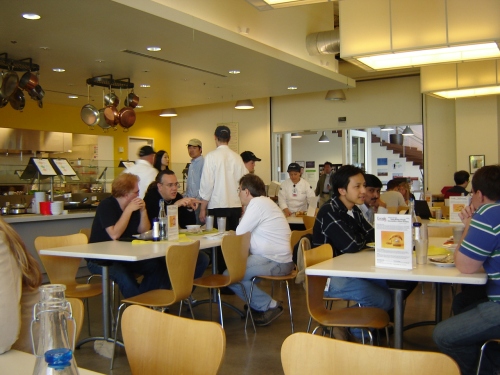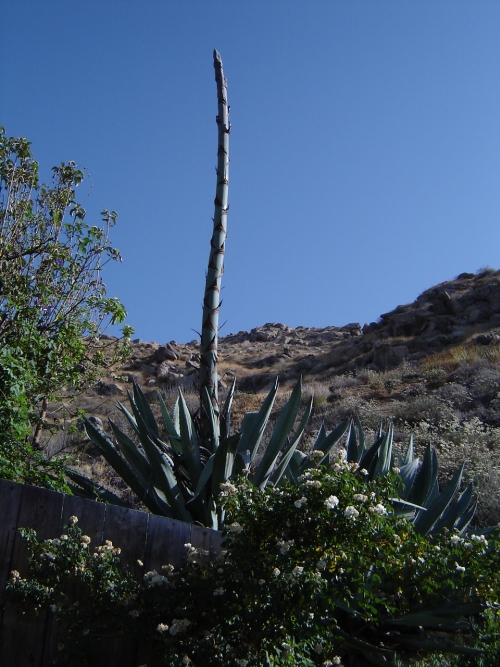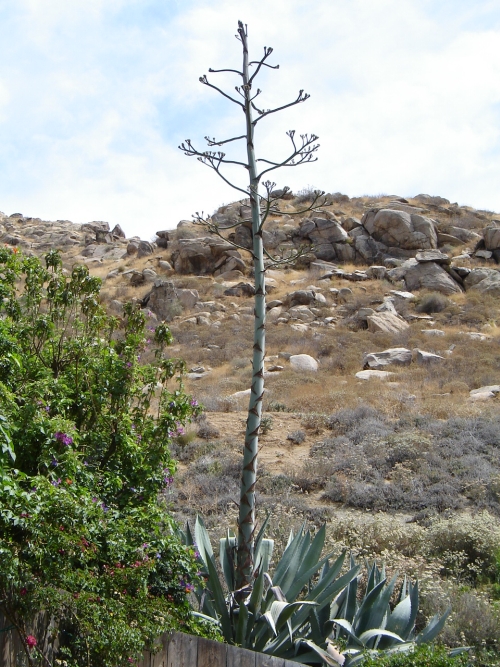
If you're feeling depressed about mysteriously crashing populations of bats and bees, amphibians, and other species, let the ginkgo be a lesson: there's a big difference between being almost extinct and being extinct. So, it pays to work hard to save species even when it seems almost hopeless.
The modern ginkgo tree is a "living fossil", the only surviving member of the phylum Ginkgophyta, which had its heyday in the Cretaceous, about 145 million years ago. The Cretaceous was the last period when dinosaurs walked the earth. During the cataclysm that killed the dinosaurs, all but two species of the ginkgo family died out. Their range has been contracting almost ever since. It's possible they had evolved to have their seeds dispersed by dinosaurs, in which case they may have been pining away ever since.
(Excuse the pun.)
Ginkgos are marked by some special features: extreme longevity, slow reproduction rate, low population density, and strong "ecological conservatism": they only like light soils around rivers. Presumably all these factors contribute to make ancient ginkgos almost indistinguishable from ginkgos today.
By the time the ice ages began — the end of the Pliocene and the start of the Pleistocene, 1.8 million years ago — they only survived in a certain part of central China.
After the apes evolved into humans and some in Europe became scientists, these western scientists found fossil ginkgo leaves and decided this was an extinct species of plant:

But, they were wrong! The ginkgo had survived in China, mainly in monasteries in the mountains and in palace and temple gardens, where Buddhist monks cultivated the tree starting around 1100 AD. Only a few wild ginkgos are known in China, especially around the southern slope of Jinfo Mountain near the border of Guizhou Province.
The Buddhists monks later took the ginkgo to Japan around 1190...
In 1691, a German physician and botanist named Engelbert Kämpfer, in Japan on a mission with the Dutch East-India Company, found ginkgos in Japan and brought back seeds to Holland. The trees from these first seeds survive today!
They were taken to America in 1784, and by the late 1800s it had become a popular tree for city streets on east coast urban areas. Now Ginkgo biloba is fashionable for its medical properties.
In short: its story continues! For more:

May 7, 2008
I gave a talk on the number 5 at George Washington University.
I'm staying with my old pal Bill
Schmitt, who teaches there.
Bill and I were math grad students at MIT, and he's one of the few people I've kept up with since then. It's strange how this sort of thing works — you can't guess ahead of time who you'll still be talking to twenty years later. Bill's interest in Hopf algebras and combinatorics seemed far from my work on quantum field theory when I was a student, but now they look awfully similar to me. We also just get along — and we've managed to see each other often enough to keep the connection alive.
First Bill had a job at the University of Southern California and lived in Venice, California, within range of Riverside. Then he got at the University of Tennesee, in Memphis, but was kind enough to invite me to give a talk there. Now he's teaching in DC, conveniently located near my parents. So, it's fun to visit him when I go to DC — especially since visits carry a certain sadness, a certain darkness now that my dad is confined to a nursing home, and my mother lives alone, struggling with some tough decisions.

The last time I visited Bill, he lived right off Dupont Circle — a fashionable spot in the heart of DC. Now he's living out in Bethesda, to be near his daughter. But a lot remains constant: in both these places, and also in Memphis, he lived near the top of an apartment building, in a sparsely furnished set of rooms dominated by a grand piano and an incredibly good stereo system.
He's one of the few people who not only loves music as much as me, but loves it in a similar way, so we can enjoy listening to it together and talking about it. I tend to think of him as a "confirmed bachelor", who likes women but needs the freedom of living alone. So, I really enjoy doing bachelor things with him: eating out at restaurants where he's a favored "regular", staying up late, listening to music, talking math, and drinking. All the stuff I'd do if I lived alone — except I'd be absolutely miserable, since living alone is not my thing. So for me, visiting Bill is like an idealized temporary taste of the bachelor lifestyle backed by the comforting knowledge that it's not a permanent condition. The part-time presence of his 4-year-old daughter throws a monkey wrench into this pattern, but somehow less than you might think. The fact that she's basically delightful helps.
Best piece of music I've discovered on this visit: Thom Yorke's album The Eraser. The first song that really caught my attention was Skip Divided, because I'd already heard the flashy remix by the German group Modeselektor over at NPR. But, I've gotten to love almost all these songs — try Black Swan, It Rained All Night, Analyse and The Eraser. I suggest ignoring the videos: I'm just using YouTube as a way to let you hear cheap versions of these songs! In their full-fledged album versions, some of these songs are so high-tech and sonically thick that they come out like pure noise on my cheaper pair of headphones... but sound great on good speakers. They're also full of soul. I like this album better than In Rainbows.
If you get stuck in other people's impressions of what you do, it actually starts informing how you carry on — and then you know you're in trouble, because then you're part of this noise that actually was nothing to do with you in the first place. - Thom Yorke
My aunt gave my dad a CD by Jimmy Giuffre, the jazz clarinetist I mentioned on April 30th. This CD is actually a double album containing Tangents in Jazz, the record my dad had that I loved so much as a kid! Wow! This stripped-down, slightly countrified jazz — dominated by clarinet, drum silent except when needed, completely lacking piano — was so far ahead of its time! It sounds like something Bill Frisell would do. It's gentle, but funky. It makes me happy.
From an online review of a larger collection:
There is a kind of poetic imagination at work in the early solo recordings of Jimmy Giuffre. He knew what sound he was looking for; could hear it in all its breezy complexity; but had to experiment for a number of years before hitting upon it: a varied and rich tapestry that may be overlooked by mainstream jazz fans who are still goo-goo-eyed over all the '50s had to offer; but shouldn't be. Taken in part or as a whole, The Complete Capitol and Atlantic Recordings of Jimmy Giuffre, (six CDs-worth from the Four Brothers sessions), reveal truly original statements sung by a master of dynamic, harmonic, and timbral invention and counterpoint. Giuffre (and Dave Brubeck) studied counterpoint with French composer Darius Milhaud, and it shows. The music contained here is considered, even today, with its strange lineups and odd ghostly voicings, to be sometimes quirky or iconoclastic.The evidence, of course, is in the recordings themselves, beginning with 1953's Four Brothers session. Giuffre alternates on clarinet, baritone, and tenor, with side men that include pianist Russ Freeman, trumpeter Jack Sheldon, bassist Curtis Counce, and drum king Shelly Manne, on half the session, and altoist Bud Shank, Shorty Rogers on flugelhorn (and subbing Ralph Pena on bass), and vibist Bob Enevoldsen. On Four Brothers, one can hear Giuffre's discontent with the idea of the piano carrying the body of the harmonic groove and the skittering of the drums during the solos.
The next step would be, of course, to jettison the piano for the scandalous (at that time) Tangents in Jazz. Featuring Giuffre and his army of horns with Sheldon, Pena, and drummer Artie Anton, Tangents in Jazz set the pens of critics to scrawling across the page. Here was a quartet set that decided the piano — even before Chet Baker — was dispensable, and that linear development and improvisation would be better served by accenting timbre and dynamic rather than an overabundance of harmonic considerations.
Right or wrong, and despite the controversy, the album has proven to be a classic. The reason is simple: Giuffre's insistence on subtle shades and textures in melodic improvisation made his music — no matter how "odd" sounding — palatable. The muted tones and nuances of Tangents in Jazz are balanced by the sheer melodic invention of the soloing of all players as they develop along contrapuntal lines, showcasing timbral shifts that would normally go unnoticed as key elements in the linear — not horizontal — erection of a series of melodic ideas in a composition; all joined by improvisation that added a block that harmony may or may not be considered as a stepping stone to another rung. And hell yes, Tangents in Jazz, like Four Brothers before it, swung smooth; but it swung tough.
He told me he jokingly refers to categorification as "higher mathematics".
I also met Jenny Harrison, and was delighted to hear that she enjoys This Week's Finds. She said that when it shows up, she knows it'll be a fun day! That's what I'm always striving for... I'm glad it's working for some people.
Lisa and I had dinner with Alan, his wife, and a postdoc. Jenny was
unable to make it.
May 22, 2008
Lisa and I are now visiting Stanford, where she gave a
talk
at the Center for East Asian Studies. This afternoon I visited
my student Mike Stay at Google — that's where he works now.

They have lots of lectures on all subjects at Google, so I gave a talk there. To make it fun for people, I decided to give my talk about the number 5. Unfortunately, it turned out I was giving it at the same time Condoleeza Rice was giving a talk! I was pleased that some people still came.
Afterwards Mike and I discussed his thesis, which will be about the analogies between computation and physics (broadly speaking) and categorifying the lambda calculus (narrowly, at least to start with). Mike was excited about something called the blue calculus, which more closely models current object-oriented programming. I need to catch up on a lot of material before I can address this sort of thing intelligently, connecting the practice of computation with the elegance of abstract category theory. But, it would be fun.
The Google "campus", as they call it, is a sight to see. Swimming pools, a Tyrannosaurus rex, a replica of Space Ship One (a spaceplane that completely the first privately funded flight in space), a bunch of video screens mapping web traffic in real time, the obligatory whiteboards all over, free coffee bars, free juice bars, free cafeterias serving all sorts of tasty food... they've clearly put thought into keeping their employees happy. I could sense myself becoming jealous.

The place is also a bit like a dream school for bright overgrown kids: lots of primary colors, toys, and all your needs met as long as you do wonderful things. That made me feel a bit nervous. As a university teacher, I'm used to being the "grownup" amid kids.
Dinner with Lisa's colleagues, including
Yiqun Zhou
and Mark
Lewis, whom I'd met before in Cambridge.
May 23, 2008
Back in Riverside, it's raining and chilly! That's a real shock,
especially since it was about 40° C when we left. But it's nice.
We have an agave in our back yard that's revealed itself to be a century plant, sending up an enormous stalk and flowering magnificently before it dies. A couple weeks ago it looked like some sort of mega-asparagus:

Now it looks like this:

How charming is divine Philosophy!
Not harsh and crabbed, as dull fools suppose,
But musical as is Apollo's lute,
And a perpetual feast of nectar'd sweets,
Where no crude surfeit reign. - Milton, Comus
© 2008 John Baez
baez@math.removethis.ucr.andthis.edu